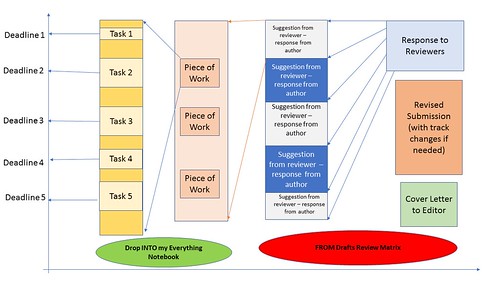This morning, as I was reflecting on a topic I’ve been mulling over (what does Joli Jensen mean by “constant contact with a writing project entail”?), I reviewed potential blog posts I could pre-schedule, and realized that there’s one that I give very little play, even though it’s a really good one: my reverse-planning technique for project planning. This technique is is also called backcasting.
… that they should back-cast their doctoral dissertation (3 papers) from the date of submission of their completed dissertation and mark milestones for drafts' submission, chapters' submission to journals, etc. I urge them to plan using a Gantt Chart https://t.co/YLCm2x6AMW
— Dr Raul Pacheco-Vega (@raulpacheco) March 7, 2019
Since I’m currently working on returning Revise-And-Resubmit (R&R) manuscripts to the editor, I wanted to explain how I break projects down into manageable pieces. Basically, I back-cast the entire paper from the deadline, breaking it down in components. For example, I have 2 R&Rs that need to go back by March 18th. I have backcast each component, starting with the response-to-reviewers.
And then, if I need to, break down each of those rows in smaller bits that I can work on regularly (on an everyday basis, if possible) https://t.co/DhllyI1Ptp – this diagram shows how I back-cast my R&Rs with work packets, deadlines and tasks. My students have to do the same. pic.twitter.com/rCclz243qw
— Dr Raul Pacheco-Vega (@raulpacheco) March 7, 2019
My revised version of this backcasting diagram includes the fact that I drop every comment INTO my Drafts Review Matrix, and then draw FROM the DRM, dropping every work packet INTO my Everything Notebook, creating daily and weekly task lists, in a very similar fashion to how I do a yearly plan using my Everything Notebook and monthly printed calendars.
Knowing what I have to do by when to have a revision resubmitted to the journal editor by a certain date allows me to plan my writing. This process works for revise-and-resubmits, first submissions, theses, conference papers and dissertations. Simply choose the type of project, and then backcast and create task lists from work packets. The beauty of this process is that you can break down the total project in as many (small or smaller) work packets as necessary.


0 Responses
Stay in touch with the conversation, subscribe to the RSS feed for comments on this post.